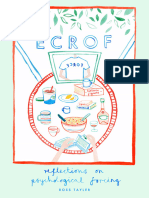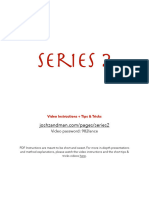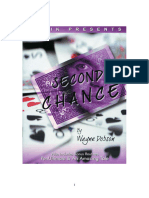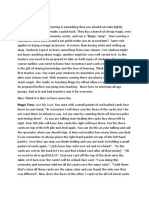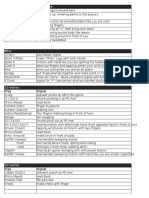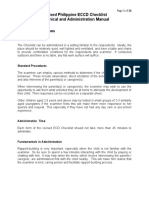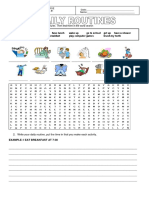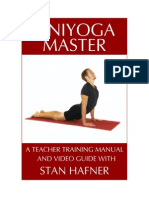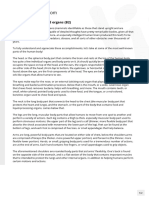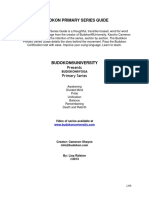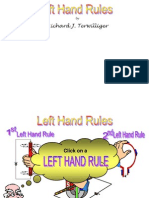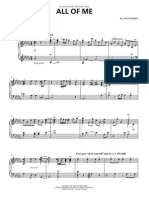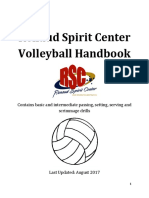This Booklet Is Free!
I mean it’s really, truly, completely free!
Anyone in the magic community can get it from this page on my website:
www.ianrowland.com/magic
where you will find lots of other completely free items for magicians. As you’ll see if
you visit this page, I don’t even use it for marketing purposes or ask you for your
email address. Free means free. I’ve created this page of free stuff as one way to
give something back to the magic community, which has given a great deal to me
and which I love.
On that page of free stuff, you’ll find a short essay called ‘Magic Is Hard’. I think
everyone in the magic community should read this.
You can copy this .pdf file and share it with your magic friends if you want to. I’d be
very grateful if you would also tell them about my page of free stuff, as mentioned
above. But don’t tell non-magicians about it!
Love to you all,
- Ian
(If anyone’s interested, I’m available for lucrative, well paid slots at major magic
conventions. Preferably the sort of convention that involves travelling to an exotic
location and staying at a 5-star luxury hotel where I get the VIP treatment and
everything is ‘on the house’.)
1
�Words Are Nowhere
I utterly love this effect.
I’ve had tremendous fun with it for decades and have performed it everywhere:
from a small cafe in Kuta, Indonesia to a bar in Kyoto, Japan; from the queue
waiting to go up to see ‘Christ The Redeemer’ in Rio to a souvenir shop in Saint
Petersburg. It’s a beautiful item to carry round with you, knowing that whenever
you want you can treat people to an intriguing close-up miracle unlike anything
they’ve ever seen before. And it happens in the spectator’s own hands!
Although I have occasionally used ‘Words Are Nowhere’ in formal shows, I usually
perform it informally in social situations whenever a good opportunity arises. If you
try this out a few times, I hope you’ll see its potential and come to love it as much
as I do.
So, what’s it all about?
Most magicians are familiar with the ‘spirit writing’ effect that’s usually performed
with a set of ‘spirit slates’. What I’m sharing here is a new way to make words
appear from nowhere in a spooky and mysterious way, apparently without any
human agency. It’s low-tech, requires no special props and can be one of your
‘everyday carry’ (EDC) items.
There are two points I’d like to emphasise.
• For laymen, this is a very powerful, strange and mysterious effect. They’ll feel
highly intrigued by what happens and remember it for a long time. I’ll have
more to say about this later.
• It’s very versatile. You can dress up this effect and present it in a hundred
different ways.
I’ve called it ‘Words Are Nowhere’ because I’m a writer and I like word play. With a
a little readjustment, ‘words are nowhere’ becomes ‘words are now here’, which is
basically the plot of the trick.
Let’s get into it.
1
�Effect
(Forgive my labouring the point, but don’t worry if the effect as I describe it here
doesn’t appeal to you. You can adapt this trick to turn it into something you will
enjoy performing.)
You show four cards that bear signs and symbols associated with divination — the
attempt to obtain secret or hidden knowledge. The audience clearly sees both sides
of all four cards as you talk a little bit about the history of divination.
A spectator holds the four cards in her own hands. Someone else present chooses a
theme or subject, e.g. ‘favourite films’. You invite the spectator holding the cards to
just think of one of her favourite films while you perform a short divinatory ritual.
When the spectator checks the cards again, she finds that on one card the word
‘Princess’ has materialised out of nowhere. On another card, the word ‘Bride’ has
appeared. The writing looks rather strange and ghostly in nature. No one watching
has any idea how this writing has appeared or where it came from. The spectator
confirms that she was thinking of ‘The Princess Bride’, the much loved classic 1987
film starring Cary Elwes, Robin Wright and Mandy Patinkin.
Method
The writing that mysteriously appears at the climax of the effect, which can be
anything you want, is there right from the start. When you display the four cards,
the audience believe they clearly see both sides of all four of them. In reality, they
never see the two sides bearing the secret writing.
I’ll divide the method into two parts: the Display Sequence and the Reveal
Sequence.
2
�The Display Sequence
I’ve made a video showing the Display and Reveal sequences described here. At
the time of writing (June 2024), it’s on YouTube with a private, unlisted URL:
https://youtu.be/QVspifT7ILo
I might take the video down at some point so if you’re reading this booklet a long
time from now don’t be too surprised if it’s no longer there.
To learn this Display Sequence, you’ll need four double-blank cards, or blank
business cards, and a black marker.
On the front of all four cards, draw a square with your marker. Just draw them
freehand and aim to make them similar but not absolutely identical. On the back of
all four cards, draw a circle.
Take any of the four cards. On the square side, write ‘Alpha’ across the face of the
card in a rough scrawl. You can do this either using the same black marker or a red
Sharpie for contrast. It doesn’t really matter at this stage when you’re just learning
the sequence. I’ve used red in the photos for clarity.
You can use almost the full surface area of the card but don’t go right to the edges.
Leave a small margin along all four sides.
Take one of the other cards. On the circle side, write ‘Beta’ across the face.
3
�Turn all four cards square side up. Assemble them in a packet like this from top to
bottom:
Card #1. Square on top, Circle on bottom.
Card #2. Square on top, Circle on bottom with ‘Beta’ scrawled across it.
Card #3. Square on top with ‘Alpha’ scrawled across it. Circle on bottom.
Card #4. Square on top, Circle on bottom.
I’ll describe the Display Sequence as if you’re right-handed. If you’re left-handed,
just swap ‘left’ and ‘right’ around in your mind. If you’ve been into magic for any
length of time, you’ll be used to doing this! Alternatively, hold the pages of this
document up to a mirror.
Hold the packet of four cards in your left hand as shown (Pinch Grip). They don’t
have to be perfectly squared up. The audience (if there was one) would see a
square on the top card. Your hands are a few inches apart.
Bring your hands together for a moment. Thumb the top card from your left hand
into your right hand and separate your hands again.
Rotate both hands at the wrist to display the circle sides. Unrotate your wrists so the
square sides are uppermost once more.
4
�Your left hand is holding three cards. By applying a small amount of thumb
pressure, get ready to thumb off the top two cards as if they’re one.
Bring your hands together and perform two actions simultaneously:
(i) With your right hand, add the single card it holds to the bottom of the cards in
your left hand.
(ii) At the same time, thumb off two cards from your left hand into your right hand.
Separate your hands.
It should look as if you have just thumbed off a second card from your left hand to
your right, to add to the first one. The photo on the left shows an exposed,
explanatory view. In real life, you keep the cards more closely aligned as shown on
the right. (This move is part of the standard Elmsely Count.)
Your imaginary audience can now see there are two cards in either hand, with
squares showing uppermost.
Rotate both hands at the wrists as you did before, displaying the circle sides of the
cards. Unrotate both wrists.
5
�Bring your hands together once more and thumb off the top card from your left
hand on to the cards in your right hand. Separate your hands. Again, only squares
can be seen. Rotate both hands at the wrists, showing the circle sides of the cards.
Unrotate your wrists.
You have one card remaining in your left hand. Show both sides of it to your
imaginary audience and then add it to the bottom of the cards in your right hand.
(In a regular Elmsley Count you would add it to the top.)
You have apparently shown both sides of all four cards, slowly, clearly and fairly. It’s
clear that all four cards have a square on one side and a circle on the other. Despite
the apparent fairness of the display sequence, the words that will mysteriously
appear later (Alpha / Beta) remain concealed.
Turn the packet of four cards over as one and hold them in your left hand. The
circle sides are now uppermost. Repeat the same Display Sequence.
Thumb the top card across. Rotate wrists. Un-rotate.
Appear to thumb the second card across. In reality, the first card gets added back
under the cards in your left hand while the left thumb pushes across two cards as
one, just as in an Elmsley Count. Separate, rotate, then un-rotate.
Thumb across the third card. Rotate and un-rotate.
Display both sides of the final card and add it underneath the other three.
You will find that you can repeat this Display Sequence as often as you like. The
hidden writing is never seen.
After repeating this Display Sequence as often as feels appropriate, you can
proceed to the Reveal Sequence.
6
�Reveal Sequence
Hold all four cards in your left hand, squares side up, just as they were right at the
start. You now separate the four cards into two pairs.
Bring your hands together. With your right hand, take away cards 2 and 4. With
your left hand, retain cards 1 and 3.
To do this, you just have to very slightly ‘step’ or spread the cards so that your right
thumb can engage with card 2 and your right fingers can engage with card 4; at the
same time your left thumb retains card 1 and your left fingers retain card 3. This will
seem fiddly at first but it’s not hard to do and you’ll get the knack after a bit of
practice.
The photo below right shows a slightly exposed view. In real life, try to keep the
cards more closely aligned so it’s a little harder for anyone to see exactly how
you’re separating the cards.
7
�Here’s the current position. You have two cards in your left hand, square side up.
The word ‘Alpha’ is on the top side of the lower card. You have two cards in your
right hand. The word ‘Beta’ is on the underside of the top card.
Turn over the two cards in your left hand as one, bringing their circle sides
uppermost.
You now have two cards circle-side up in your left hand and two cards square-side
up in your right hand. Let your imaginary audience register this picture for a
moment. You want them to remember this picture.
Use your thumbs to shift the top card of both pairs to one side, exposing the faces
of the cards beneath. The audience just see a circle and a square. The hidden
writing remains concealed. Square up both pairs of cards.
Bring your hands together and place the pair in your right hand (squares) on top of
the pair in your left hand (circles).
You have all four cards in your left hand. Turn all four over as one packet. (In
performance, this turnover will be covered and justified. But don’t worry about this
for now.)
8
�Thumb the top two cards from your left hand into your right, keeping them securely
together. Visually, the situation now looks exactly the same as it did about thirty
seconds ago: two cards circle-side up in your left hand and two cards square-side
up in your right hand. However, do not fan or spread the cards this time because
you’ll reveal the secret writing.
Place either pair of cards on to the table followed by the other pair. (In
performance, you will place them between a spectator’s hands.) When the two
pairs of cards are checked, the hidden writing, Alpha and Beta, will seem to have
mysteriously appeared on the lower card of both pairs.
Points To Note
I have already emphasised the tremendous versatility of ‘Words Are Nowhere’. Let
me just mention a few points for added emphasis.
(1) You can use any cards or card-like items you want. All that matters is that the
four cards appear identical, or very nearly so, and that you’re comfortable handling
them. I’ve used double-blank Bicycle card stock, blank business cards, rectangles of
white or coloured card or cardboard, double-blank Jumbo cards, blank postcards,
file card stock… and so on.
Whatever cards or card-like items you use, they don’t have to have a nice, smooth
finish like Bicycle cards or other brands that we tend to use when performing
magic. Even uncoated card stock works perfectly well. I once performed this trick
with four identical beermats!
(2) I’ve described the display sequence using squares to mark the upper sides of
each card and circles to mark the undersides. Obviously, this was just for
explanatory purposes. When you perform in real life, you can put literally anything
you want on the fronts and backs of the four cards: words, signs, names, symbols
or even small drawings. This means you can adapt the effect to fit any theme or
premise you want.
(3) For explanatory purposes, I’ve used ‘Alpha’ and ‘Beta’ as the hidden words that
mysteriously appear at the end. When you perform, you can make any two words
or names appear. I usually base the routine around a two-part name, such as a rock
band (Pink / Floyd), a location (New / York), a film title (Princess / Bride) and so on.
Again, you can adapt the routine to suit any preferred theme or premise.
Moving On
At this stage, you know what ‘Words Are Nowhere’ is all about: spooky writing
appearing from nowhere. You know that the performance involves a Display
Sequence (in which two of the eight surfaces involved are cunningly concealed)
and a Reveal Sequence.
Now let’s consider how to actually perform ‘Words Are Nowhere’.
9
�Presentation #1
I have performed many different versions of ‘Words Are Nowhere’. Here’s one
presentation that I’ve had plenty of fun with. I’ll describe it here in case you like it
and want to do something similar.
This presentation involves a small amount of stooging (although it won’t matter if
people realise this afterwards) and a minute or two of pre-show work. If you
strongly dislike stooging and pre-show, then (a) we can never be friends, and (b)
see ‘Presentation #2’ later in this booklet which is virtually impromptu.
Materials
Here are the materials I use for this presentation. Adapt as you see fit.
• Four double-blank Bicycle cards. You can use any four cards or card-like
items you want, so long as they’re blank on both sides.
• A Sharpie W10 medium black marker with a chisel tip. This gives a thicker
line than a regular Sharpie. Any medium-thickness marker will do.
• A fine red Sharpie marker.
• A piece broken from an incense stick, about three inches long (7.5 cm), plus a
lighter. The incense sticks I buy and use at home are about 8 inches (20 cm)
long. I find full-length sticks a bit impractical to carry around. This is why I
break off a piece about 2-3 inches long.
10
�Preparing The Cards
On the front of each card, draw a Pentagram with the black marker. On the back
of each card draw the Eye of Horus. Here’s what the symbols are supposed to
look like and how I draw them (not very accurately) on the cards.
As you can see, I’m not an artist. I suggest you always draw these symbols
freehand. The fact that the ‘artwork’ is flawed and imperfect is okay and, I think,
more suited to this effect than something that looks pre-printed or too neat.
Aim to make the four symbols (of both sets) look similar but not identical. Draw
them so they are quite large but leave some of the surface area blank. This means
there’s more room for the ‘spooky writing’ to appear later on.
Have all four cards with the Pentagram on top and square them up into a packet.
Stash these in your wallet, purse, close-up case or pocket and you’re good to go.
You’ll also need to take with you the red Sharpie, the short piece of incense stick
and the lighter.
11
�Performance
For this explanation, let’s say you’re hanging out informally with a few friends —
some you know well and some you’re meeting for the first time. Two of the new
people are a couple called Andy and Katy. Using whatever judgment you’ve gained
from performing magic for a while, you reckon that Andy won’t mind being a good
‘stooge’ for you and that Katy will love the ‘Words Are Nowhere’ effect.
Contrive to get a minute or so alone with Andy. Briefly explain that you’re going to
be doing a bit of magic later on, just for fun, and you’d like to make it really special
for Katy. Explain that you just need a bit of personal information about her, such as
her favourite singer or band; favourite book, film or TV show; favourite place or
holiday destination; names that mean a lot to her such as her parents or other
relatives; favourite celebrity or fictional character; favourite sports star… and so on.
Explain that you’re looking for two names, two words or something you can split
into two words.
Suppose Andy says that Katy’s favourite film is ‘The Princess Bride’. (This is a good
suggestion. You will make ‘Princess’ and ‘Bride’ appear on the cards.)
Tell Andy that, during the trick, you will list a few categories such as music, books,
places, characters and so on. Say you’ll invite him to choose one and you’d like
him to dither a bit and then choose ‘Films’.
Thank Andy for his help, ask him to keep this just between the two of you and
promise you’ll buy him a drink later.
Note that you do not tell Andy anything about the trick you’re going to perform or
that it involves writing appearing from nowhere.
Go somewhere where you can secretly finish off the preparation of the cards.
On one of cards, on the Pentagram side, use the red Sharpie to scrawl the word
‘Princess’ across the face of the card. You do want this to be legible. You do not
want it to look neat and tidy. It’s okay to use a mix of upper and lower case letters
and for the letters not to be aligned.
On another card, on the Horus side, scrawl the word ‘Bride’ in a similar way.
12
�Stack the four cards from top to bottom like this.
Card #1. Pentagram on top, Horus on bottom.
Card #2. Pentagram on top, Horus on bottom plus ‘Bride’.
Card #3. Pentagram on top plus ‘Princess’, Horus on bottom.
Card #4. Pentagram on top, Horus on bottom.
You’re all set!
Rejoin your group of friends. At some later juncture, when the mood and the
moment is right, someone asks you to do a bit of magic or you just launch into
performing mode. Say you’ll perform a little magical something for Katy although
everyone can watch and enjoy it. Take out the four cards and explain what this is
all about.
“I’m fascinated by the subject of divination… the attempt to obtain hidden or secret
knowledge. Let me share two interesting points about this. First of all, systems of
divination are found in literally every civilisation, all over the world, and in every
historical era. It seems that wherever you go, people have this fundamental desire
to tap into secret knowledge. The second point is that, for some reason, it always
seems to involve signs or symbols. Like these two.”
In a relaxed and casual way, go through the Display Sequence while you talk about
the Pentagram and the Eye of Horus. You can repeat the Display Sequence as
many times as feels right, comfortable and appropriate. Never look or sound like
you’re doing a slick card trick that involves counting four cards. Never look or
sound as if you’re trying to prove anything. You’ve just brought along a couple of
interesting symbols so you can chat about them. That’s all.
“Do you know what this one is? Yes… it’s the five-pointed star or pentagram. In this
country it’s been associated with Wicca, paganism and Satanism. But there are very
similar signs found in many different rites and rituals. For example, it features in
some African beliefs and traditions, which is why you’ll find it on the flags of
Morocco and Ethiopia.
“And do you know this one? It’s called the Eye of Horus. We tend to associate it
with ancient Egyptian culture. Horus was the god of the sun and the sky. But very
similar signs are found elsewhere, such as Polynesia, in the Kabala and in the
Indian legend of the Third Eye Of Shiva.
“Anyway, let’s see if this divination stuff actually works!”
You now go into the Reveal Sequence. Start by separating the four cards into two
pairs as explained before. Get to the point where you thumb the top card of both
pairs aside to show that all seems innocent and above board. The secret writing
remains concealed.
“Jane, can you just hold out your hand for me, palm up.”
13
�Whatever Jane does at this point, feign the need to make some adjustment such as
turning to face her more squarely, moving something on the table out of the way,
slightly changing the way she’s holding out her hand or brushing away an
imaginary bit of fluff on your sleeve… use any ruse that works.
You put the two pairs of cards together so you’ve got one hand free, which you use
to adjust her hand, move something from the table or do whatever you’re
pretending needs to be done. You turn the whole packet of four cards over. Once
you’ve done whatever you pretended you needed to do, bring your hands together
and separate the cards into pairs once more. Never draw attention to this move or
explain or excuse it.
Place the first pair of cards on to Jane’s outstretched palm. Add the red Sharpie,
uncapped, warning Katy to be careful and not to get ink all over her. Add the
remaining pair of cards. Ask Jane to place her other hand on top of the whole lot,
palm down, to keep everything together.
“We could make this about any sort of knowledge or information but Jane, you’re
the star today, so let’s make it all about you. Let’s see if we can find out a bit of
your personal information! Er… Andy, you choose. Shall we work with favourite
singers and bands, books, films, places, the names of Jane’s family and relatives,
favourite celebrities… or what?”
Andy ponders the options for a moment and ‘chooses’ films.
“OK then, that’s our theme.”
Take out the small piece of an incense stick, light it and wave it around, under and
over Jane’s hands in a manner that looks suitably theatrical and mysterious.
“Jane, don’t say anything but just think about your favourite film or, if you have
more than one, think of two or three of your favourite films. Don’t just think of them
but think of how you feel about them. Feelings are important.”
Proceed with the divinatory ritual, inviting Jane to manifest her thoughts and
feelings while you waft the incense around her hands. Carry on with this for as long
as feels right and appropriate. You do want everyone present to feel intrigued. You
don’t want them to feel bored. In some of my own past performances, this part has
lasted anything from twenty seconds to about a minute and a half, depending on
the mood of the moment.
Extinguish the incense and invite Katy to see if anything has happened. She
discovers that some strange writing has manifested on the cards: ‘Princess’ and
‘Bride’! She confirms that this is either the film she was thinking of or it was among
the ones she thought of. Either way, she will look pretty amazed, intrigued and
astonished.
Help Katy to display the strange, spooky writing to everyone present so they can all
see what’s happened. The cards can of course all be examined. You give them to
Katy to keep as a souvenir.
14
�Notes On Presentation #1
It doesn’t matter if Katy guesses that you asked Andy about her favourite films —
which she probably will. You might think it would matter, but it really doesn’t. I’ve
been performing this effect for decades and I’ve found it makes little difference. The
central mystery is not about how you knew she liked ‘The Princess Bride’. It’s about
how some writing appeared out of nowhere.
To lay audiences, this is a profound mystery — especially since they can check the
cards as much as they want (and they are usually very keen to do so).
The display sequence is powerfully deceptive for lay people. What’s especially
deceptive is the part near the end, when you separate the cards into two pairs: a
Pentagram pair and an Eye of Horus pair. You fan or flair the cards and everything
looks normal. A few seconds later you appear to be in exactly the same position.
(You have in fact turned both pairs of cards over but nobody will register this.) But
now, when the upper cards are moved aside, the magical writing appears!
To a lay audience, it seems that you somehow caused the writing to appear after
the first time you spread or fanned the pairs of cards. This presents your audience
with an unsolvable mystery.
Presentation #2
If you hate pre-show and trusting people to do a bit of stooging for you, here’s an
alternative. This is the always-ready-to-go version that you can present on an
almost impromptu basis.
Prepare the four cards as for ‘Presentation #1’, with Pentagrams on one side and
the Eye of Horus on the other. The two words you’re going to make appear are
‘Trust’ and ‘Yourself’, so apply these to the cards using the red Sharpie. Set the
cards up in the right order and you’re good to go!
To perform, go through the usual preamble about divination being a part of every
civilisation in every era in history. You get to the part where Katy is holding the
cards between her hands. Invite her to think in general about any concerns or
issues that are on her mind or in her heart at the moment (without going anywhere
dark or upsetting). In particular, invite her to focus on issues where she might have
one opinion but people around her might have a different opinion. Make it very
clear that you will not ask her what issue she’s thinking about. This will remain
locked within the privacy of her own mind.
Go through the divinatory ritual with the incense. Say, “So, let’s just ask the powers
that be for a bit of advice or guidance. Who knows what strange powers or sources
of wisdom are around us all the time? Even if you’re very sceptical and rational, the
one thing we all know is that we don’t know everything. So, let’s just keep an open
mind, and an open heart, and see what happens.”
Bring the effect to an end and Katy sees that ‘the spirits’ have left her a little
message: ‘Trust Yourself’. She can keep the cards as a souvenir of this strange,
intriguing and slightly spooky moment.
15
�Creating Spooky Writing
You can have fun experimenting with different ways to add the spooky writing that
appears at the end of the effect. For simplicity, in this booklet I’ve just mentioned
scrawling the revealed words using a red Sharpie. But there are many other options
to explore. Depending on the type of cards you use, and their finish, you could add
the spooky writing using pastels, wax pencils (also known as ‘china’ markers),
artist’s charcoal and so on. Try different materials and see if you can create some
suitably ghostly effects. If you come up with some good ideas, let me know!
When I use a red Sharpie to add the spooky writing, I hold it by the very top, as
shown, using my right hand (the hand I do not normally write with). I then try to
write the word I need e.g. ‘Princess’. I find this is a good way to get rather spidery,
scrawly, untidy writing that is legible but looks rather strange.
After I’ve added the spooky writing, I sometimes also momentarily hold the card
over a lighter flame, to get a mild charring effect and some soot. This doesn’t show
up very well in the photo but it looks good in real life.
Why Is It So Powerful?
[Any naked flame is dangerous. Always take appropriate fire safety precautions. If
you are under 16, do not attempt this technique without adequate adult
supervision. You undertake any use of a lighter entirely at your own risk. Ian
Rowland does not accept any responsibility for any harm, accidents or damage of
any kind arising from the use of a lighter as suggested in this booklet.]
16
�Why Is It So Powerful?
At the start of this booklet, I said that the effect of writing appearing from nowhere,
and without any apparent agency, is a very powerful one. Why is this the case?
We all instinctively understand that where there is writing, there must be a writer, a
human mind. Writing doesn’t occur in nature and no other species uses written
communication to anything like the same extent as human beings.
This being the case, whenever writing appears without there being any clear source
or agency, it feels distinctly weird and mysterious in a way that we can all respond
to on a gut level. This is the case even if the words that appear don’t seem to have
any direct relevance to you. If the words do have personal relevance, the effect is
greatly amplified.
The ‘writing from nowhere’ trope features in more than a few tales of horror and
the supernatural. In the Bible, in the book of Daniel, we get the story of Belshazzar's
feast where writing mysteriously appears on a wall. In ‘The Exorcist’, one of my
favourite books and films, the words ‘Help Me’ mysteriously form on Regan’s skin.
In ‘The Shining’, one of the characters has a vision of the word ‘Redrum’
spontaneously appearing on a door (spoiler: it’s ‘murder’ backwards). There are
many other examples. When the spiritualist movement started, the majority of
seances involved the spirits helpfully scrawling messages on chalkboards.
Although the magical effect of writing from nowhere is very old, it seems to have
waned in popularity in recent times. Perhaps this is because the prop most often
used — the ‘spirit slates’ — became increasingly difficult to pass off as anything
other than a weird prop, unless your act was overtly historical in nature.
In his phenomenal book ‘The Trick Brain’, Dariel Fitzkee lists 19 categories of
magical effects. Unless I’ve missed something, the effect of writing from nowhere
isn’t included. (I know he refers to ‘Production > appearances’, but unless I’m
mistaken he’s clearly referring to the appearance of objects such as a billiard ball or
a rabbit from a hat).
I think it’s time for ‘spirit writing’ to come back into vogue. It is a subtle, powerful,
intriguing and memorable effect. Also, it makes a nice charge from card tricks.
(Even though ‘Words Are Nowhere’ is essentially a re-purposed Elmsley Count!)
17
�Make It Your Own
I have emphasised that ‘Words Are Nowhere’ is highly versatile and adaptable.
I’ve already mentioned that you can use any cards or card-like items you want.
They can be any size that you feel is practical and suitable for your performance. I
have used Jumbo and other large-format cards for special occasions.
You can put any signs, shapes, symbols or drawings you want on the fronts and
backs of the cards. You can just draw whatever you want to use by hand, as I do, or
get the cards properly printed (though I feel this is less effective). All that matters is
that you seem to have four identical cards with the fronts distinct from the backs.
The theme can be anything you want. I like to chat about the theme of revelation
and the symbols associated with it but you could come up with something
completely different.
The four cards (appear to) have ‘Kirk’ on the front and ‘Spock’ on the back. At the
end, images of Captain Kirk and Mr. Spock appear. Now it’s a trick about ‘Star
Trek’ and the transporter room that featured in the series.
The four cards have Valentine hearts on the front and white doves on the back. At
the end, the names ‘Romeo’ and ‘Juliet’ appear (or the names of the couple at the
wedding where you’re performing). Now it’s a trick about love and romance.
The four cards have drawings of low value coins on the front and of different low
value coins on the back. At the end, two images of gold coins appear. Now it’s a
trick about wealth, alchemy and trying to ‘transmute’ gold from cheap metals.
The four cards have the zodiac circle on one side in blue and on the other side in
red. At the end, the spectator’s own zodiac sign appears, both the name and the
appropriate symbol. Now it’s a routine about astrology.
The four cards feature drawings of a book on either side (with the fronts distinct
from the backs). Two spectators think of words from a book and their chosen words
appear on two of the cards. Now it’s a mentalism routine about books, literature
and the joy of reading.
The four cards feature Mickey Mouse on one side and Donald Duck on the other.
Someone makes a ‘free choice’ of another Disney character from a list. At the end,
two drawings of that character appear; or maybe one card shows the character and
another shows something associated with him, such as Aladdin and his lamp. Now
it’s a trick about Disney cartoon characters.
I don’t think I need to labour the point any further.
All I suggest is that you don’t use this effect in conjunction with playing cards or
make it look and feel like a card trick. Don’t force a card (e.g. the 6H) and then
have the words ‘Six’ and ‘Hearts’ appear. There’s a time for good card tricks and
there’s a time for ‘Words Are Nowhere’. Personally, I don’t think there’s much to be
gained from mixing the two.
18
�Credits
Alex Elmsley invited the Ghost Count which is now more commonly known as the
Elmsley Count.
I am grateful to Thom Chesser for providing me with the following information,
none of which I was aware of. An Elmsley Count in which the final card is placed
underneath the others is called an Underground Elmsley. See ‘Underground
Elmsley by Phil Goldstein’ https://geniimagazine.com/wiki/index.php/
Elmsley_Count. Larry Jennings is also credited: https://www.conjuringarchive.com/
list/search?keyword=underground+elmsley.
Max Maven also devised what he called the Ghostback Count, which combines
elements of the Elmsley and Flushtration counts. Scott Creasey has published
material on ‘spirit writing’ with double-blank cards. For example, see ‘White Spirits
in Minimalistic Metaphysical Mentalism’.
Thank you, Thom!
I don’t know who else to credit. I’m not claiming to have invented any of the
constituent elements of ‘Words Are Nowhere’. I have just combined them in what I
sincerely believe to be an original way. If someone else has already come up with
this, I’ll be happy to update this booklet or even delete it from my page of free
magic stuff if they insist.
Thanks And Acknowledgments
Nathan Earl arranged the ‘hands-on’ session at The Magic Circle during which I first
taught this effect to other magicians. George Edward-Nygma Smith, Aiden Heritage
and Tom Bar all kindly donated blank cards for use during this session.
Jon Ahjudah Barr and Shaun McCree helped me with research for this booklet.
Jo Ker Perfect, Mrs. Joker, Nick Adams, Keith Blakemore-Noble and Adam
Bownass helped me by checking they could follow the instructions.
Thom Chesser proofed the booklet for me to his usual high standards and also
helped with the crediting as you can see above.
---
Written and published by Ian Rowland, June 2024. I always like hearing from old
magic friends and making new ones.
ian@ianrowland.com
19
�20



















